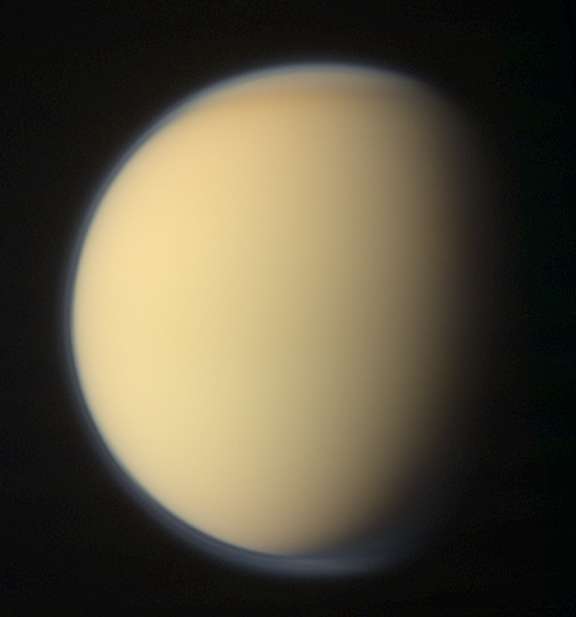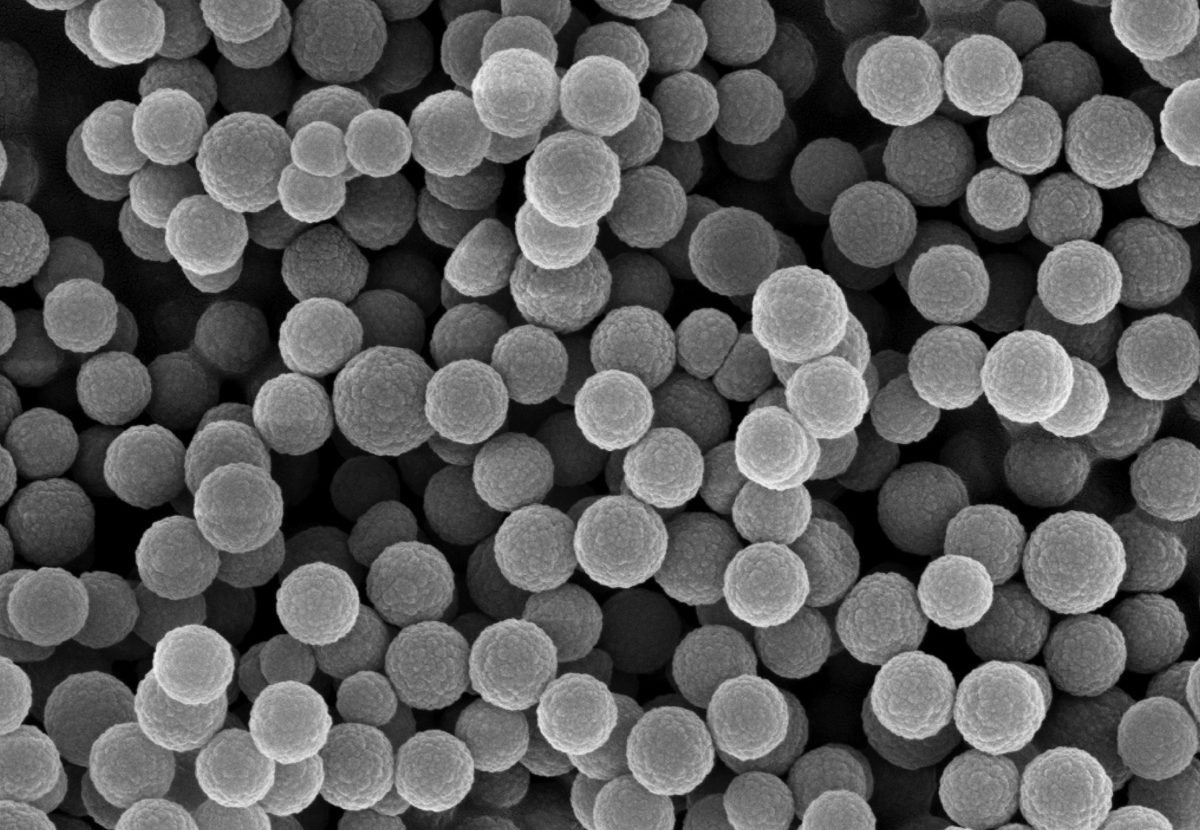Sarah Hörst • May 15, 2013
Doing a science on Titan
Titan is probably one of the most interesting objects in the solar system. So why is Titan so cool? Titan really grabbed the attention of scientists after the Voyager spacecraft flew by it during the early 80s. Although I wasn’t around at the time, my guess is that Titan was interesting not because of what Voyager scientists saw, but because of what they didn’t see. And that is pretty much everything.
Images from Voyager showed an orange, essentially featureless, ball. The atmosphere, thick and full of haze, would not allow us to see the surface. And Titan kept its secrets for another 25ish years, until the arrival of Cassini. I could go on and on about all the things we know about Titan now- its lakes that are so reminiscent of Earth (except they are made of gasoline), the dune fields and spectacular methane storms, but that isn’t why I’m here.

Instead I want to talk about why Titan’s atmosphere is so amazing. Titan’s atmosphere is made almost entirely of molecular nitrogen (2 nitrogen atoms bonded together) with a few percent of methane and a tiny bit of carbon monoxide. Once you add some sunlight to that mixture you have a recipe for something that very familiar to anyone who has been to the LA basin, smog.
At the top of Titan’s atmosphere, ultraviolet photons from the sun are able to break apart the methane and nitrogen (which is no small feat, because N2 has a triple bond!). The fragments then react to form all kinds of complex organic (this means a carbon atom bonded to a hydrogen atom) molecules. Eventually, through processes that we do not really understand, these molecules combine to form the haze that kept Titan’s secrets for so long.

One of the major, although less publicized, discoveries from Cassini is that there are very, very large molecules at the top of Titan’s atmosphere. These molecules are something like 1,000 times bigger than methane and are located at around 950 km altitude in Titan’s atmosphere (a bit farther than driving from LA to Vegas and back). This came as a big surprise because we had no idea that the chemistry could progress that far in an atmosphere at all and it is even more surprising that it can happen so high in the atmosphere, where the density is quite low. At that altitude a molecule can travel something like a kilometer before it crashes into another molecule, so chemistry can take a while.
But we know the molecules are there, so the obvious question is what are they? Sadly, Titan will keep a few more secrets from us because the instruments carried by Cassini are not capable of identifying these molecules. So to really know the answer, we need to send another spacecraft. The current estimated launch date for a hypothetical mission is a good 10-20 years from now. Add in travel time to the Saturnian system and you are talking 20-30 years until we get more data.
We are not patient people.
So what do we do? Well, for years people have been simulating Titan’s atmosphere in the lab. Take a gas mixture similar to Titan’s atmosphere and then put a whole bunch of energy into it to break apart the molecules that we started with and the fragments of those molecules react to form more complex molecules. Eventually you end up with solid "stuff" that varies in color from yellow to black and in texture from powder to guck depending on the experimental setup. We call this stuff "tholin", a word coined by Carl Sagan and Bishun Khare more than 30 years ago.
Then you pick your favorite lab analysis technique and try to figure out what you made. Usually everyone starts with molecular nitrogen and methane, and ends up with a whole bunch of hydrocarbons, nitriles, amines, imines and all sorts of other horrible chemistry words, which just mean different combinations and arrangements of carbon, nitrogen, and hydrogen. Thousands, or maybe even tens of thousands of different types of molecules are produced, from the two molecules, N2 and CH4, that we started with. It is pretty mind boggling. It is also kind of a mess. It's the perfect project for a graduate student.
I started studying tholins as a graduate student and we did the gas mixture a little bit differently. Cassini found out another cool thing about Titan: there are oxygen ions flowing into Titan's upper atmosphere. These ions probably come from Enceladus, the tiny moon with a giant plume flowing out of its south pole. A few years ago I published a paper showing that this oxygen is the source of CO in Titan's atmosphere. But what we really want to know is, what happens to that oxygen when it runs into those big molecules in the upper atmosphere?
So we put a little CO in our gas mixture just for fun.
When we analyzed the resulting solid (ours is a brownish powder) we found something rather surprising: amino acids and nucleotide bases. All of life on Earth is based on this small set of molecules. Amino acids are the building blocks of proteins and nucleotide bases are one type of building block of DNA. One nucleotide base, adenine, also forms part of a molecule called adenosine triphosphate (ATP), which is the molecule used to store energy by all of life on Earth. We see glycine and alanine (the two smallest amino acids) and all five nucleotide bases.
One big question about the origin of life on Earth is where these molecules originally came from. Our Titan atmosphere simulation experiment shows that it may be possible to make amino acids and nucleotide bases in Titan’s upper atmosphere, and perhaps in atmospheres in general that contain the basic components (nitrogen, hydrogen, carbon and oxygen).
Of course, it is pretty much impossible to replicate any atmosphere in a laboratory for reasons that would take a whole other post to explain. But this experiment can be used to motivate further atmospheric modeling. Now we know we can make these things in a laboratory. Now the question is, how are they formed? Once we figure out how they are formed (through what kind of reactions, how fast etc.), then we can look at models of Titan’s atmosphere (or the early Earth or extrasolar planets) and figure out if they might form there too. If they can form there, how much will there be, and is it enough to be detectable by different kinds of instruments you might fly on a spacecraft? Then, once we go back to Titan, we will be able to look for those molecules.
It sounds like an awful lot of work, but in fact we would've done those middle steps anyway even if we had actually found the molecules in Titan's atmosphere first. One of the reasons that the organic molecules made in Titan's atmosphere are so interesting is that Titan and Earth have the only thick nitrogen atmospheres in our solar system. So by studying the kinds of chemistry that can occur in Titan's atmosphere, we will hopefully learn about chemistry in Earth's atmosphere as well. If those molecules really are present in Titan's atmosphere, then we have the opportunity to investigate their formation in real time in an atmosphere, a real life planetary scale laboratory.
Like any good scientific story, it sounds rather neat and tidy now. But a year elapsed between the moment that my code told me that the molecular formulas were in our data (and I was the only one on the planet who knew this, what a rush!) to the moment that we confirmed the structures of the molecules. It was another two and a half years before the paper was finally published. We had to make new samples, analyze the new samples, make new samples again (this time with isotopically labeled gases to make sure the molecules we were seeing weren’t from someone sneezing in the vial), analyze the new samples, etc.
The worst part of the wait involved two months of not working on the project while I waited for a one-liter bottle of C18O (isotopically labeled carbon monoxide) to cross the Atlantic Ocean on a boat. Seriously. Our collaborators at a lab in Paris make the samples. We couldn't find a European supplier and the pressurized canister of toxic gas can't be transported on a plane. When the bottle got to the port in France, it had to go on a truck to Paris. The tiny bottle was in a giant container that was loaded onto a truck, whose driver assumed he was carrying 3000 kilograms of cargo rather than 3. When he arrived at the lab, he opened the container to reveal a cavernous space with a tiny box in the middle. Between bursts of laughter, he apparently remarked that he couldn’t figure out how he had been able to drive up the hills so quickly.
I arrived at the lab shortly after the bottle (thankfully it only takes me 9 hours to cross the Atlantic, though the bottle did have much roomier accommodations than coach) and I must admit that I've probably never been so happy to see an inanimate object in my life.
That bottle contained about 24 hours of gas for our experiment and from it we produced only 1 milligram of sample. Those were precious little vials, which I carried, and obsessively compulsively checked on for 3 tortuous hours, on the train from Paris to Grenoble to perform mass spectrometry.
Once in Grenoble, we stared at the vials for two solid days before we got the courage to put them in the mass spectrometer. They were analyzed with the greatest care and the day that the last of the data were analyzed, and we knew that it had actually worked, was the best day of my scientific career. The vast majority of scientific research involves failure, repeated and sometimes overwhelming failure, but the moments of success, the moments when you realize that you are the only person on the entire planet that knows this very tiny little piece of truth about the universe, are very addictive.
When I first observed Titan from a 14-inch teaching telescope at Caltech, I was overwhelmed each night by the fact that humankind had figured out how to build devices that would let you see this tiny (on a cosmic scale) moon that is unimaginably far away. It was the most amazing feeling. But it pales in comparison to how I feel when I look up at they sky now and see Saturn, knowing that we, humankind, amidst the chaos of our daily lives, built a spacecraft, got it off of our planet and put it in orbit around a planet that is so distant it looks like a star. And now we have evidence that we may be able to learn about the origin of life on Earth and perhaps elsewhere in the universe by learning more about Titan's atmosphere.
Support our core enterprises
Your support powers our mission to explore worlds, find life, and defend Earth. You make all the difference when you make a gift. Give today!
Donate

 Explore Worlds
Explore Worlds Find Life
Find Life Defend Earth
Defend Earth




